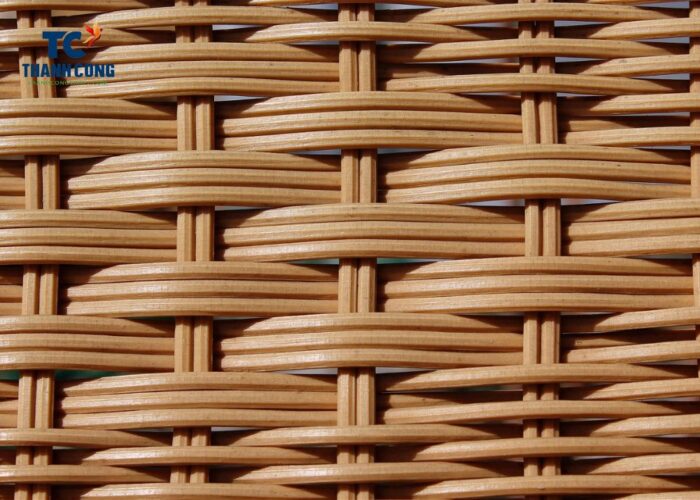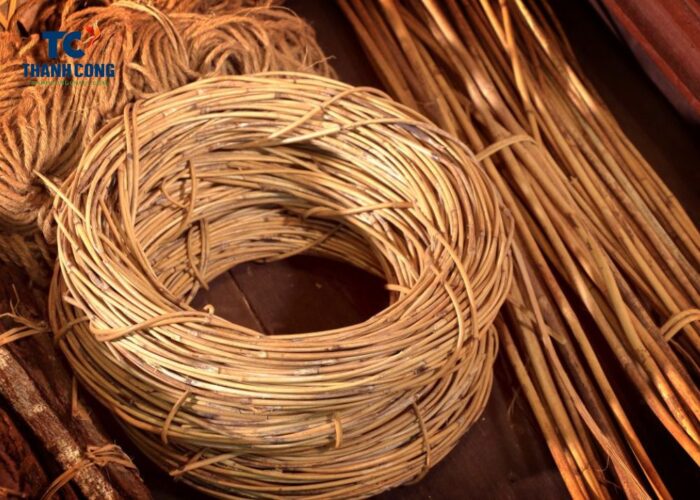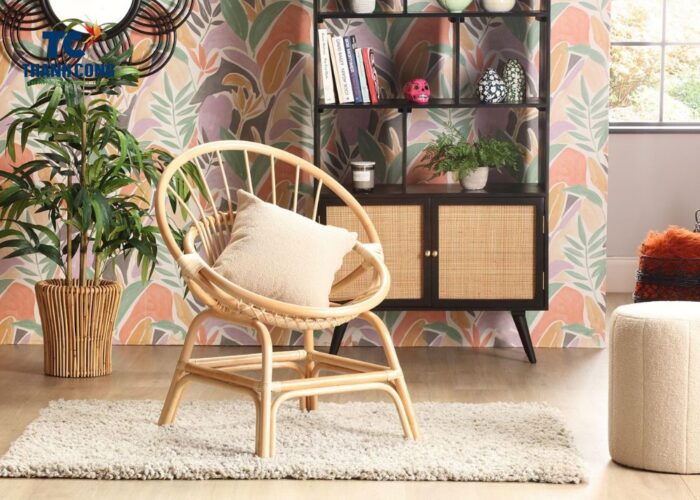One of the important factors to consider when choosing furniture is the material. There are many different types of materials used to make furniture, such as rattan, bamboo, seagrass, and jute.
Wicker furniture is a concept that encompasses furniture made from the materials mentioned above. However, if you find yourself confused by these concepts, please refer to the following article.
So, what is the difference between wicker and rattan?
Contents
1. What is The Difference between Wicker and Rattan?
The basic difference between the two lies in the fact that rattan is a type of material, whereas wicker refers to a weaving technique.
Wicker refers to a technique used in making various items, typically baskets, furniture, and decorative pieces. Wicker furniture is made from flexible plant materials, such as willow, rattan, reed, bamboo, etc.
The term can also refer to items made from this woven material, such as wicker chairs, wicker baskets, or wicker picnic hampers.

Wicker is often associated with materials like rattan and willow. Nevertheless, the term “wicker” can encompass various other natural and synthetic fibers. This broad categorization is why it’s not feasible to make direct strength comparisons between rattan and wicker.
2. What is wicker?
2.1. What is wicker made from?
As previously mentioned, wicker is a style or weaving technique used in the creation of homeware and furniture from pliable plant materials. Wicker encompasses not only natural materials (referred to as natural wicker) but also synthetic fibers (known as synthetic wicker).
In Vietnam, several popular natural materials used for wicker include water hyacinth, seagrass, rattan, bamboo, and jute. Synthetic fibers, on the other hand, encompass materials such as vinyl, resin, polyethylene, and more. Therefore, any baskets crafted from these pliable fibers can be classified as wicker baskets.

2.2. Difference between natural and resin wicker
Natural Wicker: Natural wicker possesses exceptional strength and unique aesthetics, making it an ideal choice for indoor use. However, it is sensitive to moisture and should be kept away from wet or highly humid environments, as well as direct sunlight. Exposure to such conditions can result in color fading, mold growth, or the wicker becoming excessively dry, brittle, and prone to breakage and cracking.
Resin wicker: Synthetic wicker consists of non-natural materials, such as resin and poly rattan, commonly used in the production of furniture and homeware. Suppliers often aim to replicate the appearance of rattan weave with synthetic wicker.
One of the significant advantages of synthetic wicker is its suitability for both indoor and outdoor use. It is renowned as an all-weather wicker due to its impressive durability, resistance to moisture, immunity to fading, staining, and cracking in the presence of sunlight and outdoor conditions. Additionally, synthetic wicker is easy to clean and typically more budget-friendly compared to natural wicker.
3. What is rattan?
3.1 What is rattan made of?
Rattan is a natural thorny climbing plant, with long, hard and firm stems. The rattan stem has a diameter of 1-5 cm, and can reach up to about 30 meters. The rattan stem has a thickness that is almost uniform throughout its length. Physically, the rattan peel and thorns are shiny yellow. Meanwhile, the rattan core can have different shades of color such as natural white and brown, depending on the species and region.
Rattan has long been famous for its durability and flexibility. This material is also light, making it easy for users to handle and move. With its durable and strong properties, rattan products can work well for at least 5 years and more.
An interesting thing is that rattan can withstand humid and extreme temperature conditions better than some other soft fibers. However, rattan should not be used outdoors continuously because it is not completely waterproof and weather resistant. If rattan products are left in the bathroom or humid environment for too long, they can get moldy and reduce the strength of rattan.
3.2 Types of rattan
Real Rattan: Real rattan is a type of rattan extracted from real plants and has not undergone intensive processing. It is a natural and durable resource, often used for furniture, decoration and handicraft products. Real rattan is flexible and strong, but it is also sensitive to humidity and high temperature, and can lose color and hardness if not preserved properly.

Synthetic Rattan: Synthetic rattan is a synthetic material designed to mimic the shape and color of real rattan. Usually made from polyethylene (PE) or other synthetic materials, synthetic rattan is often used for outdoor furniture and decoration. It is water-resistant and can withstand the impact of strong sunlight, something that real rattan cannot do. Synthetic rattan can be easily cleaned and usually has a lower cost than real rattan.
Depending on the purpose of use and personal preference, you can choose between real and synthetic rattan to create indoor and outdoor decoration or handicraft products according to your style.
3.4 Is rattan wicker good for outdoor?
Cane Rattan:
Cane rattan refers to the layer of rattan found just beneath the thorny outer skin. This layer is carefully extracted, cleaned, dried, and smoked before it’s utilized. Cane rattan is renowned for its flexibility and durability, making it an ideal choice for weaving chair seats and backs. Additionally, it’s often employed as a wrapping material around furniture frames, similar to rope. Cane rattan boasts a natural shine and tends not to absorb stains effectively, which is why many cane chair backs and seats are left in their natural color.
Reed Rattan:
Reed rattan constitutes the inner, wood-like portion of the rattan plant, characterized by its fibrous and porous nature. Unlike cane rattan, reed is absorbent and can be stained. Decorative elements on wicker furniture are frequently crafted from reed, including the intricate swirls and curls found on some Victorian-era wicker furniture pieces.
Synthetic Rattan:
Synthetic rattan is an engineered material designed to mimic the appearance of real rattan and is commonly used in outdoor furniture and home decor. Composed primarily of polyethylene (hence the “PE” in the name), synthetic rattan is resistant to both moisture and intense sunlight, qualities that can harm natural rattan. While there are various types of synthetic rattan, PE-based materials are known for their eco-friendliness and superior quality. They are readily available in Vietnamese rattan furniture products.
Himalayan Rattan:
Originating in the Himalaya Mountains of northeast India, Himalayan rattan is derived from the Plectocomia genus, a high-climbing palm species that can reach impressive heights of up to 80 feet. This rattan variety exhibits exceptional weather resistance, enduring frigid temperatures and even snowfall. Despite its ornamental appeal, Himalayan rattan is seldom employed in furniture due to its soft pith. Instead, it finds use in creating items like Himalayan “singing bowls,” where rattan wands of varying densities produce distinct tones and sounds.
Manau Rattan:
Manau rattan is highly sought after for its remarkable durability and strength. It hails from the Calamus genus, the most widely utilized genus in commercial rattan production. Found across regions like Africa, India, Sri Lanka, China, Malaysia, and Vietnam, Manau rattan is primarily employed in crafting rattan furniture and handicrafts. It also boasts a historical significance, having been used for weapons, particularly in various martial arts disciplines involving hand-to-hand combat.
In summary, wicker and rattan are two different concepts. Wicker is a method of weaving various materials such as bamboo, grass, plastic, metal, or wood to create products such as chairs, tables, baskets, or lamps. Rattan is a type of climbing plant belonging to the palm family with soft and flexible stems, often used as a material for wicker weaving. Both have their own advantages and disadvantages, depending on the needs and preferences of the user. I hope this article has helped you understand better the difference between wicker and rattan. If you have a shopping need, don’t hesitate to get in touch with thanhcongcraft via email info@thanhcongcraft.com or WhatsApp: +84967485411. Hope to serve you soon!












